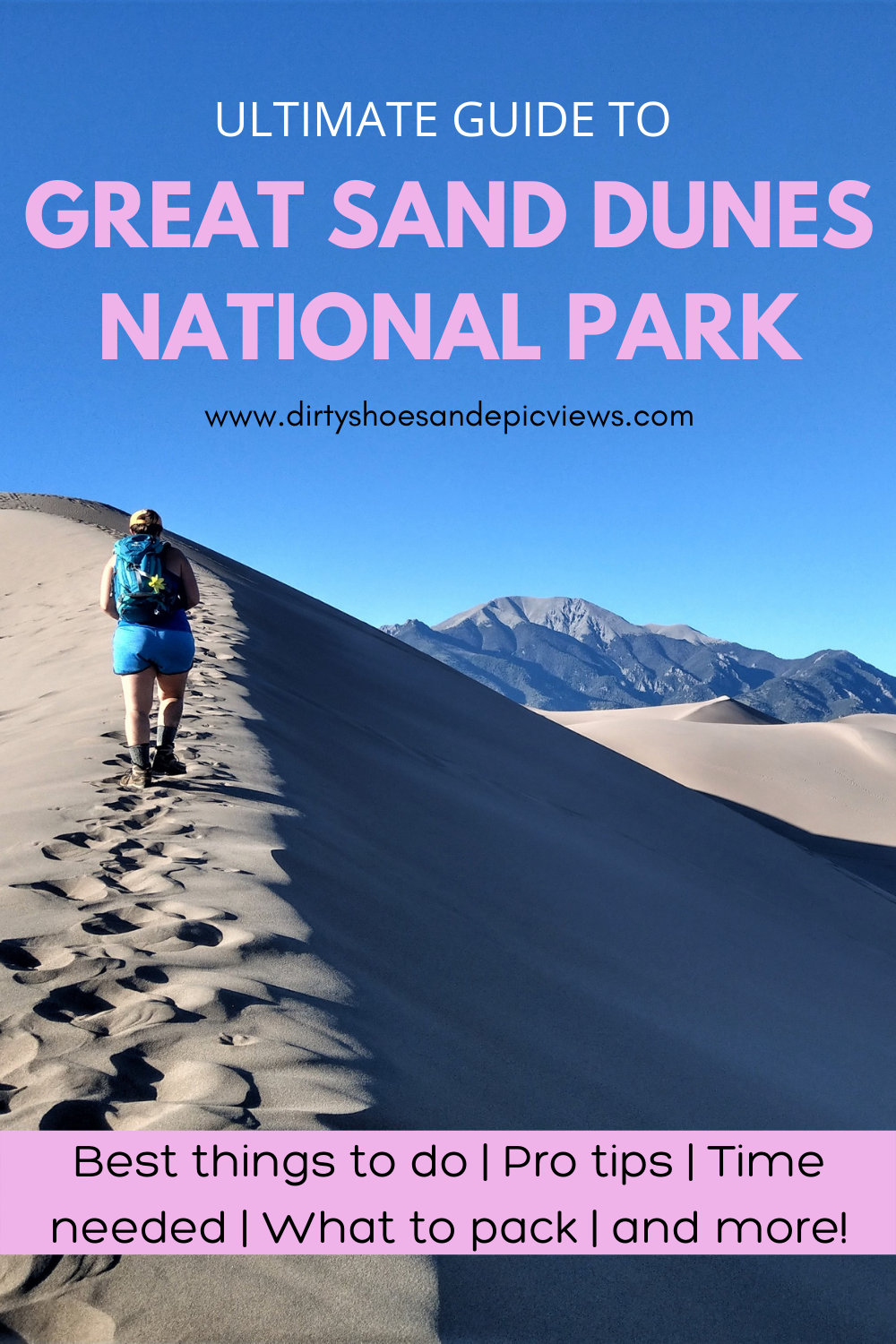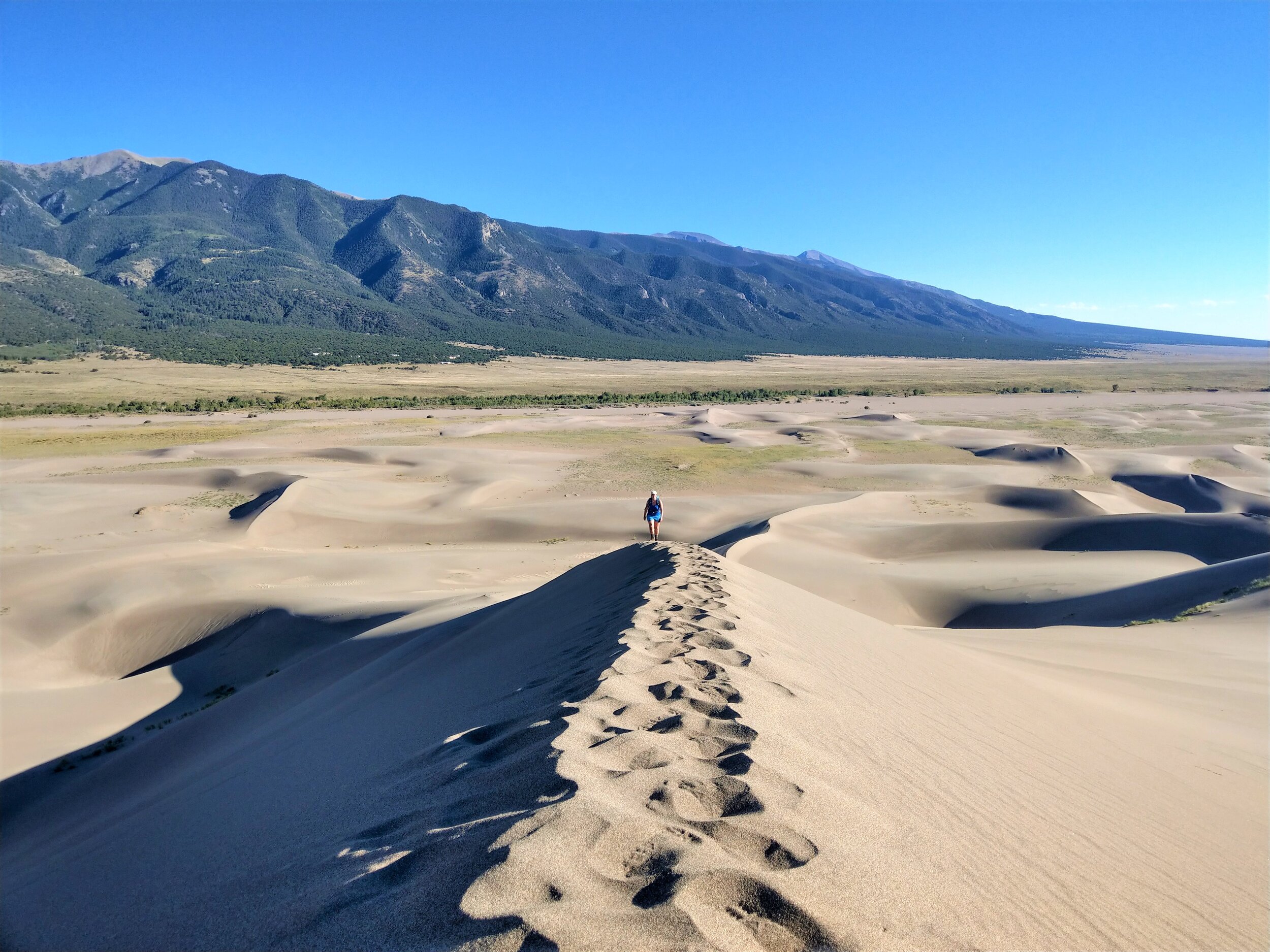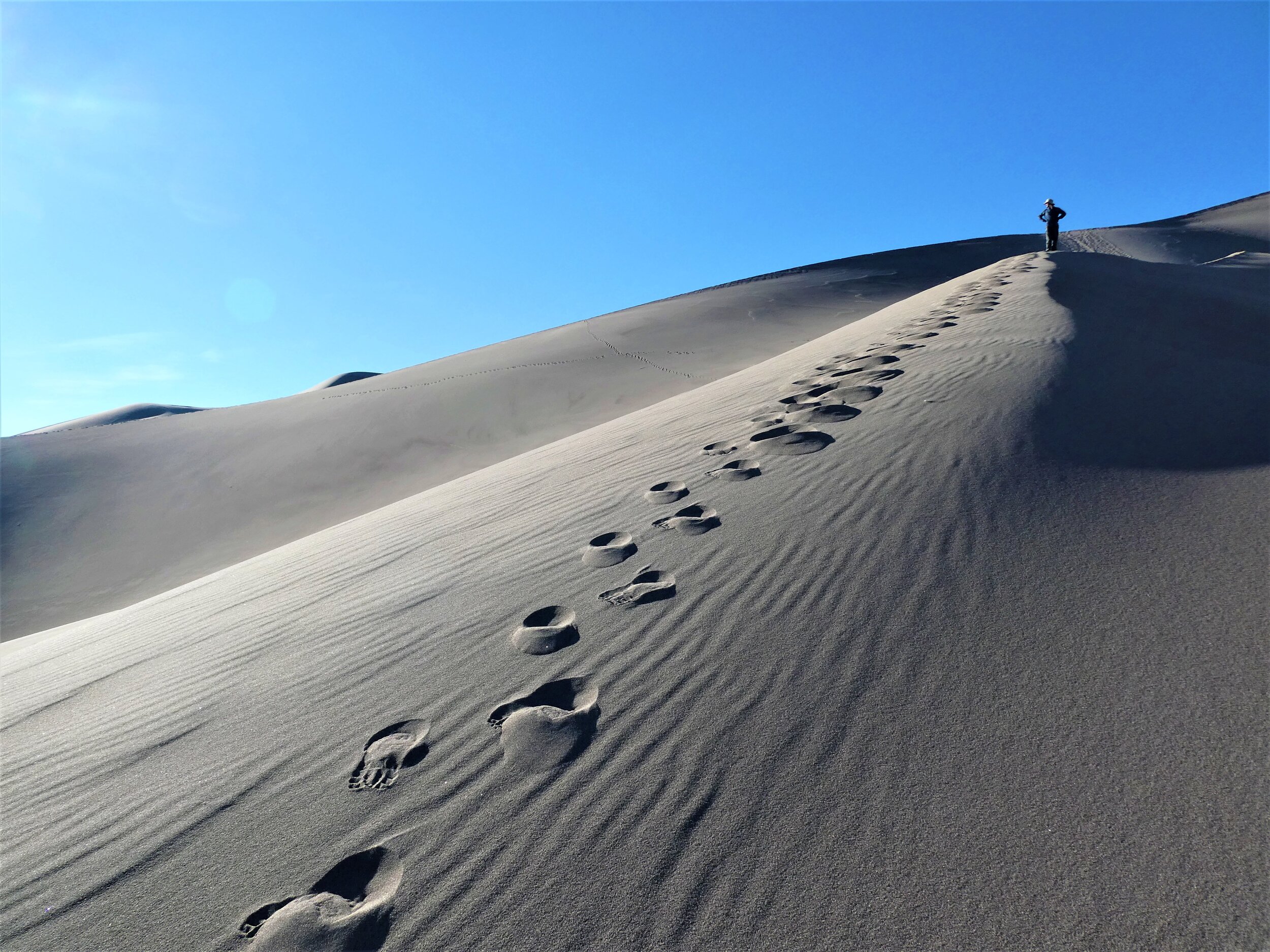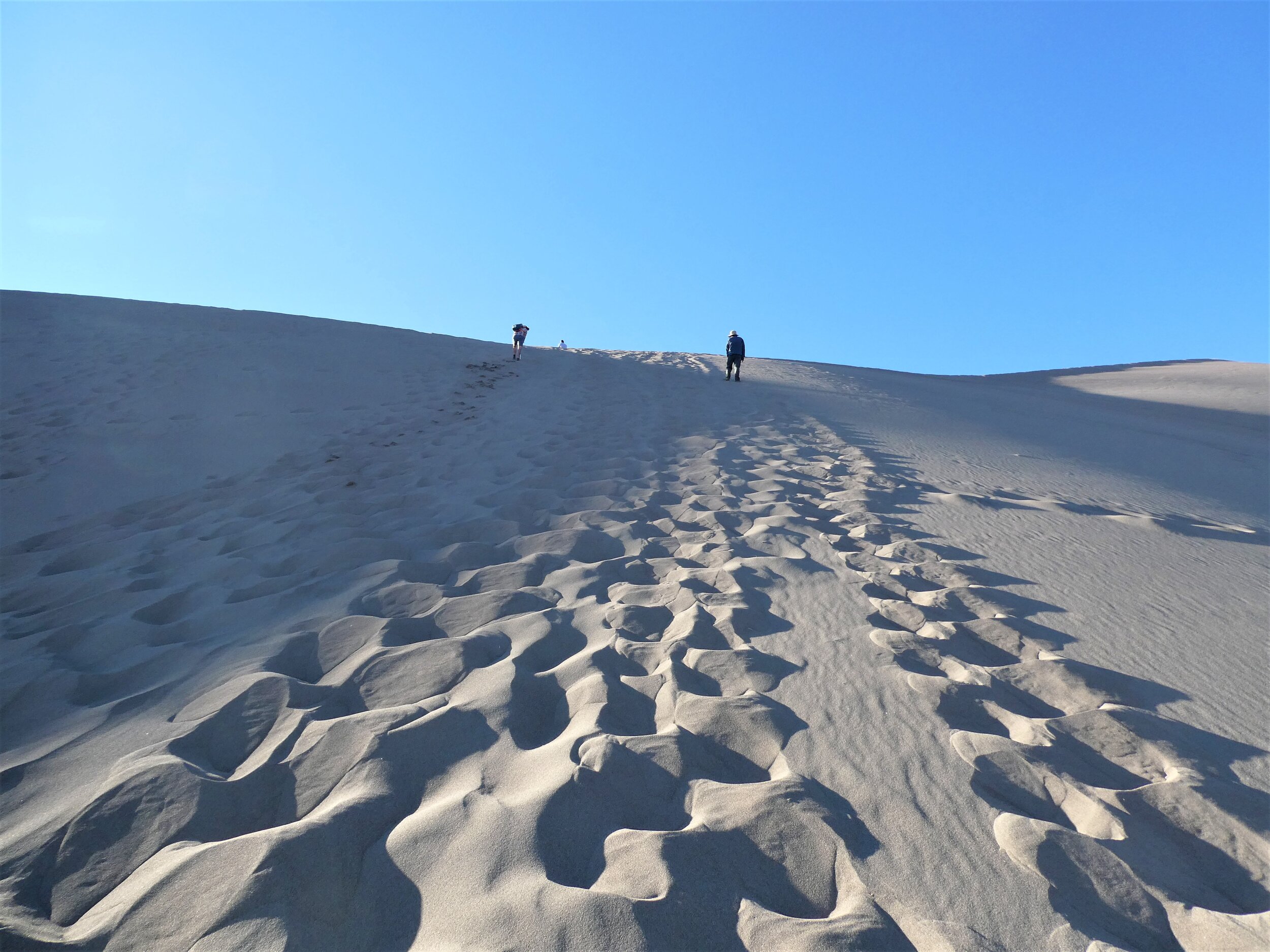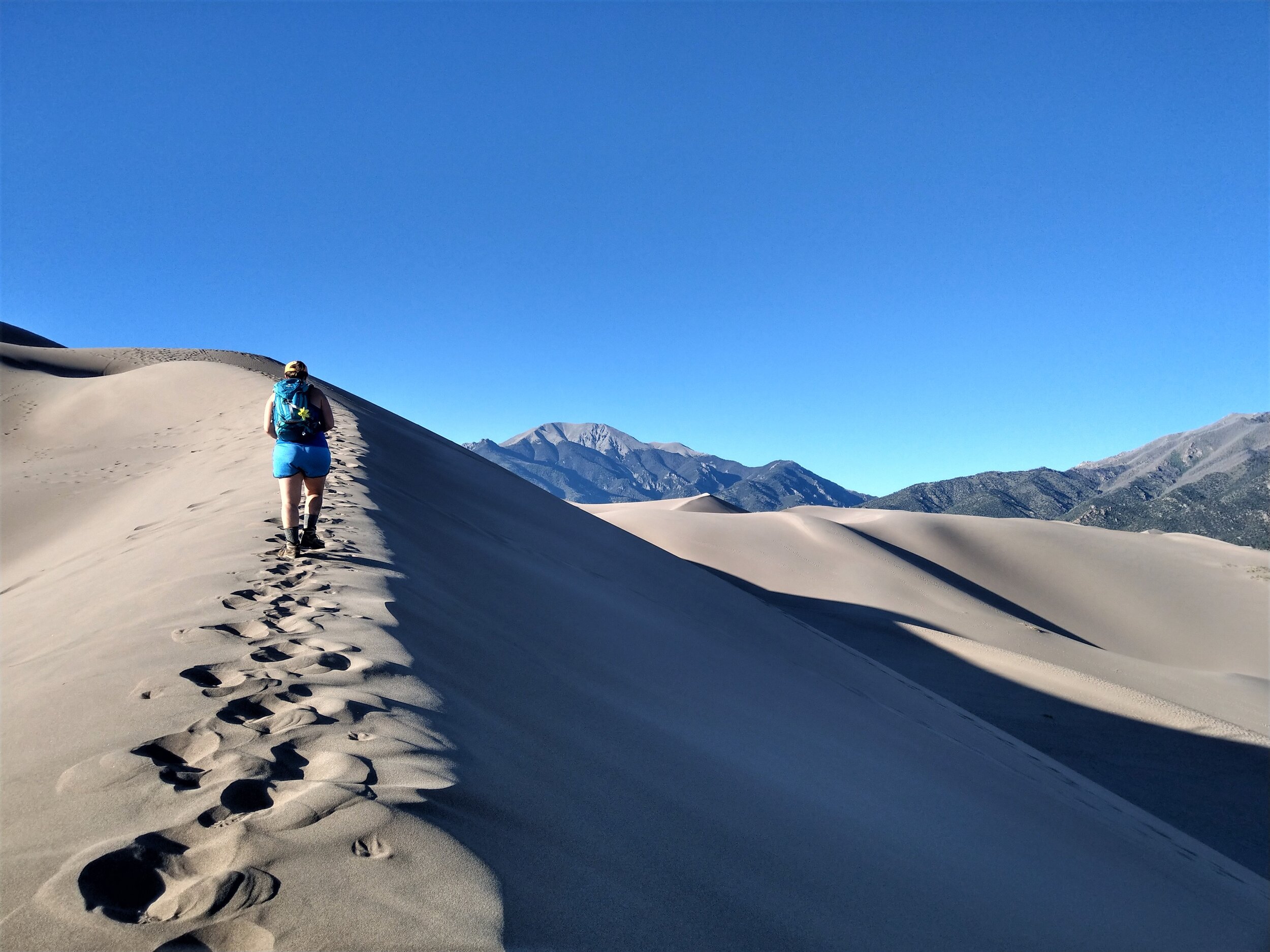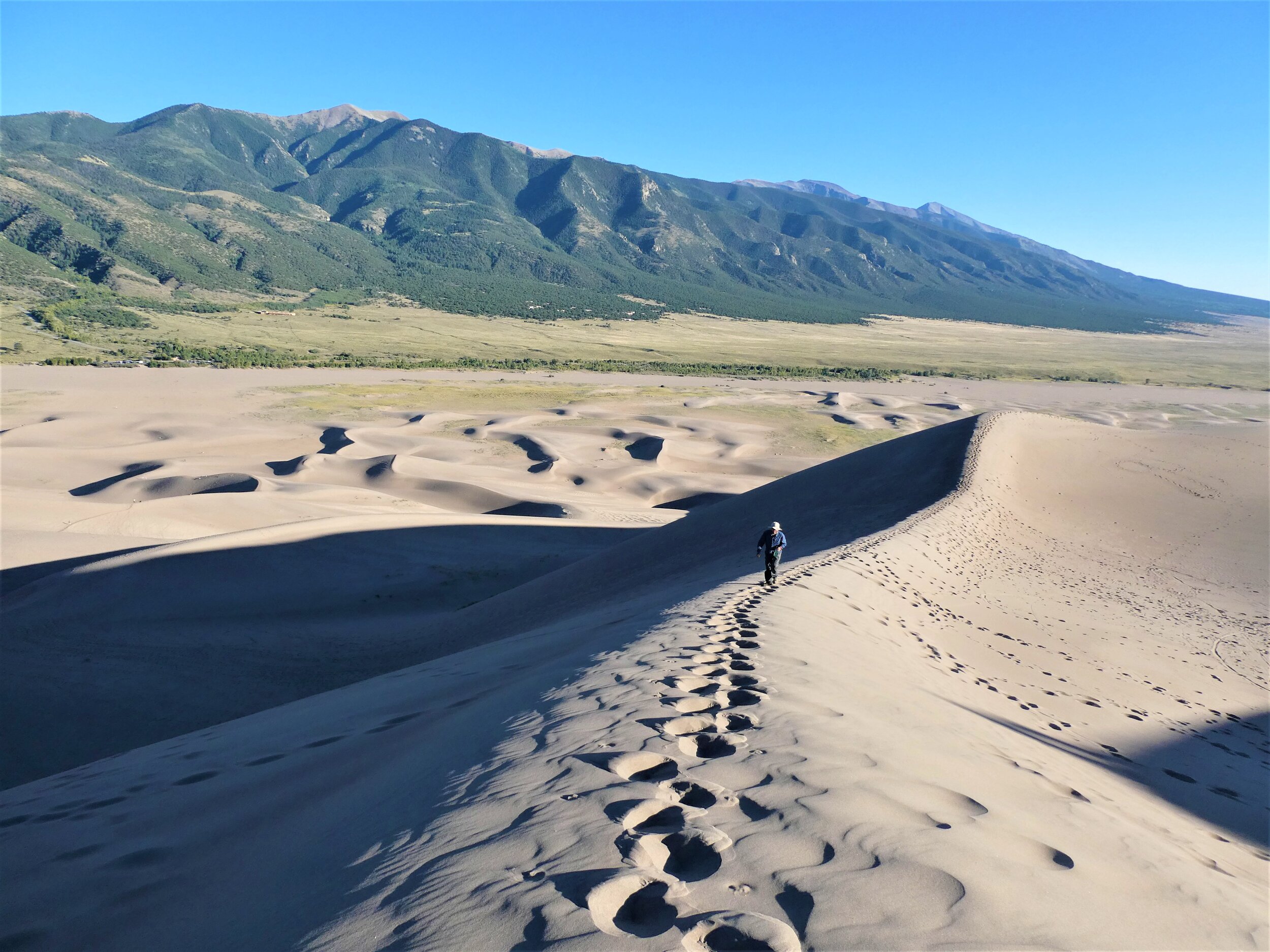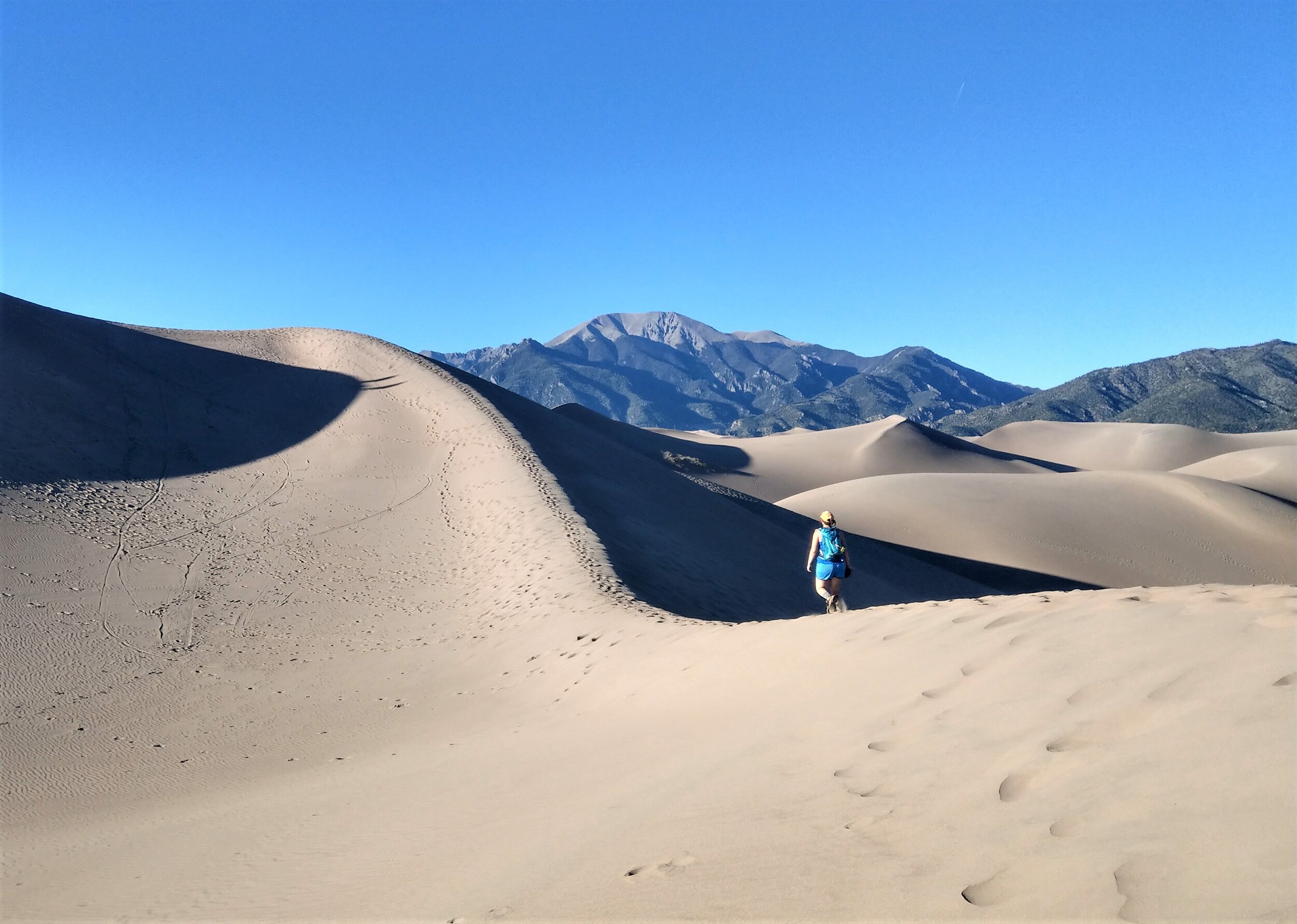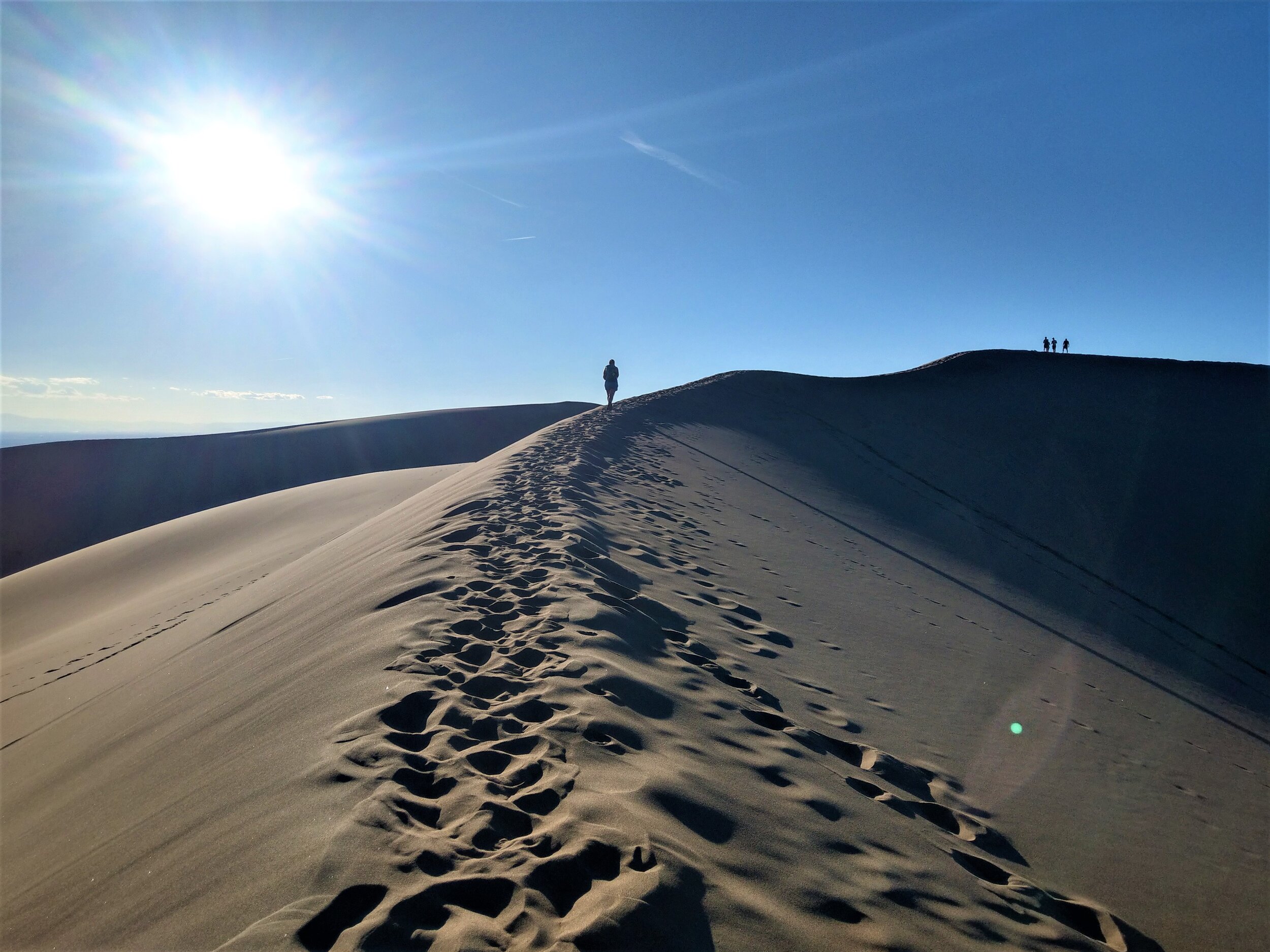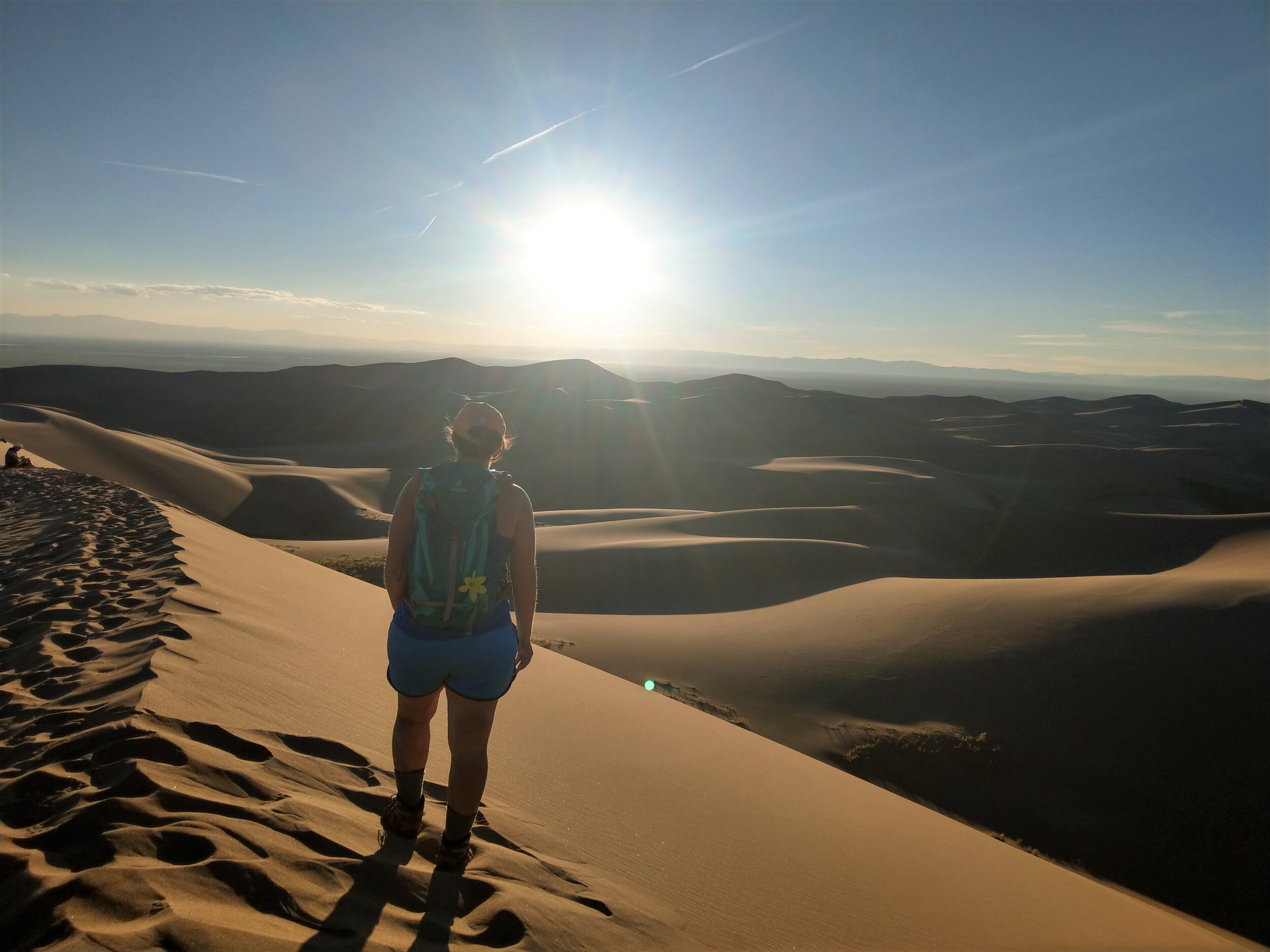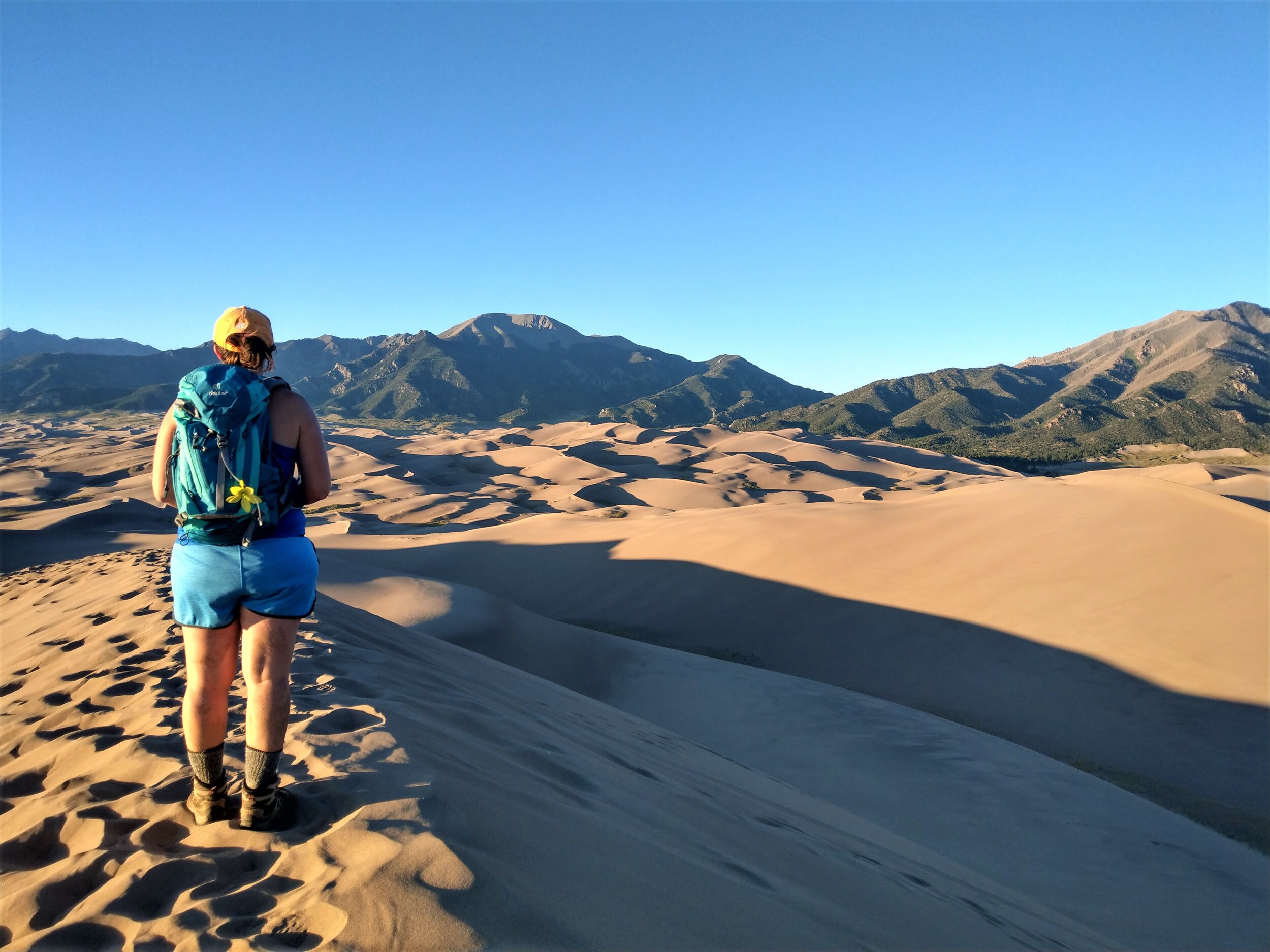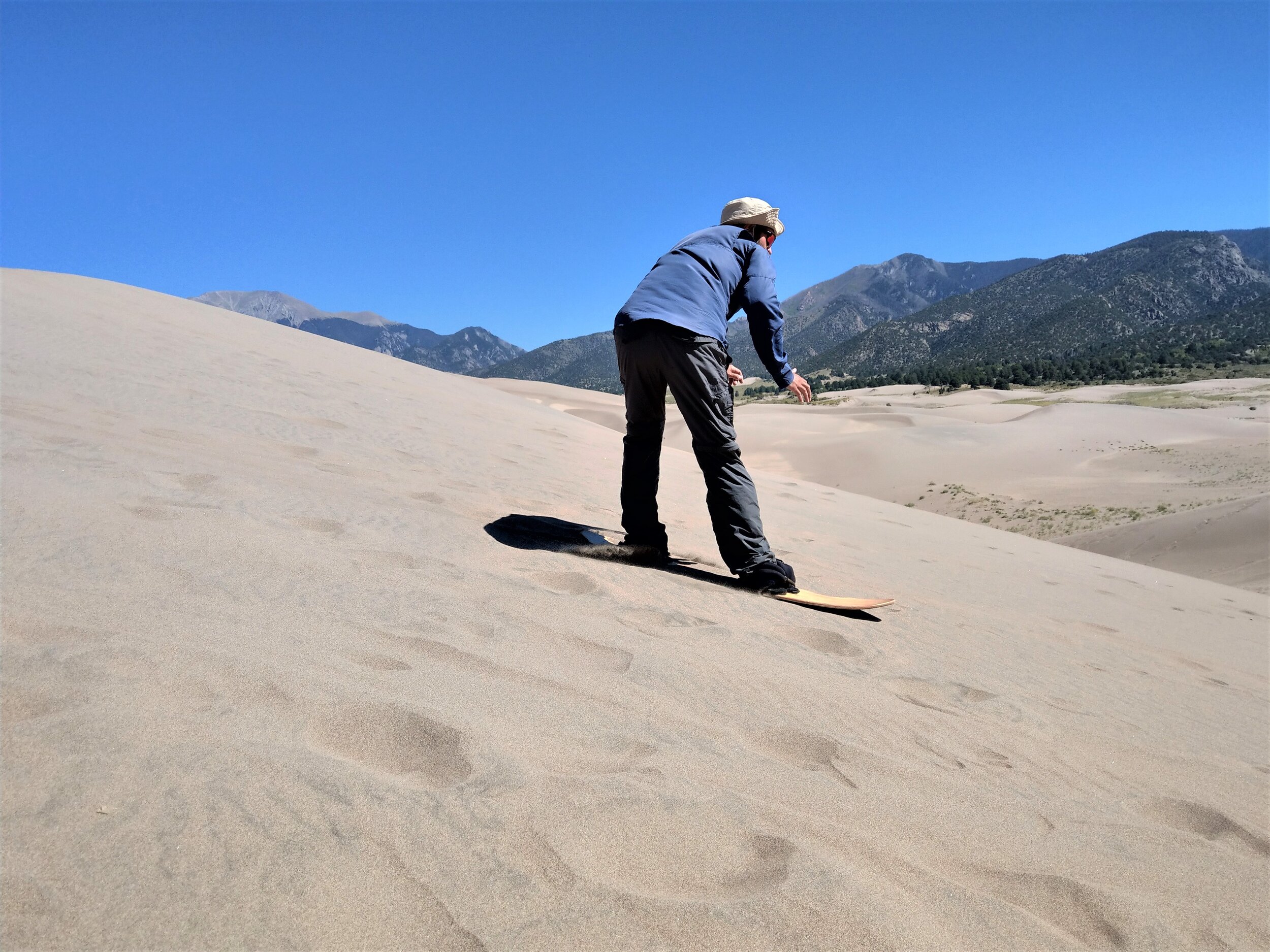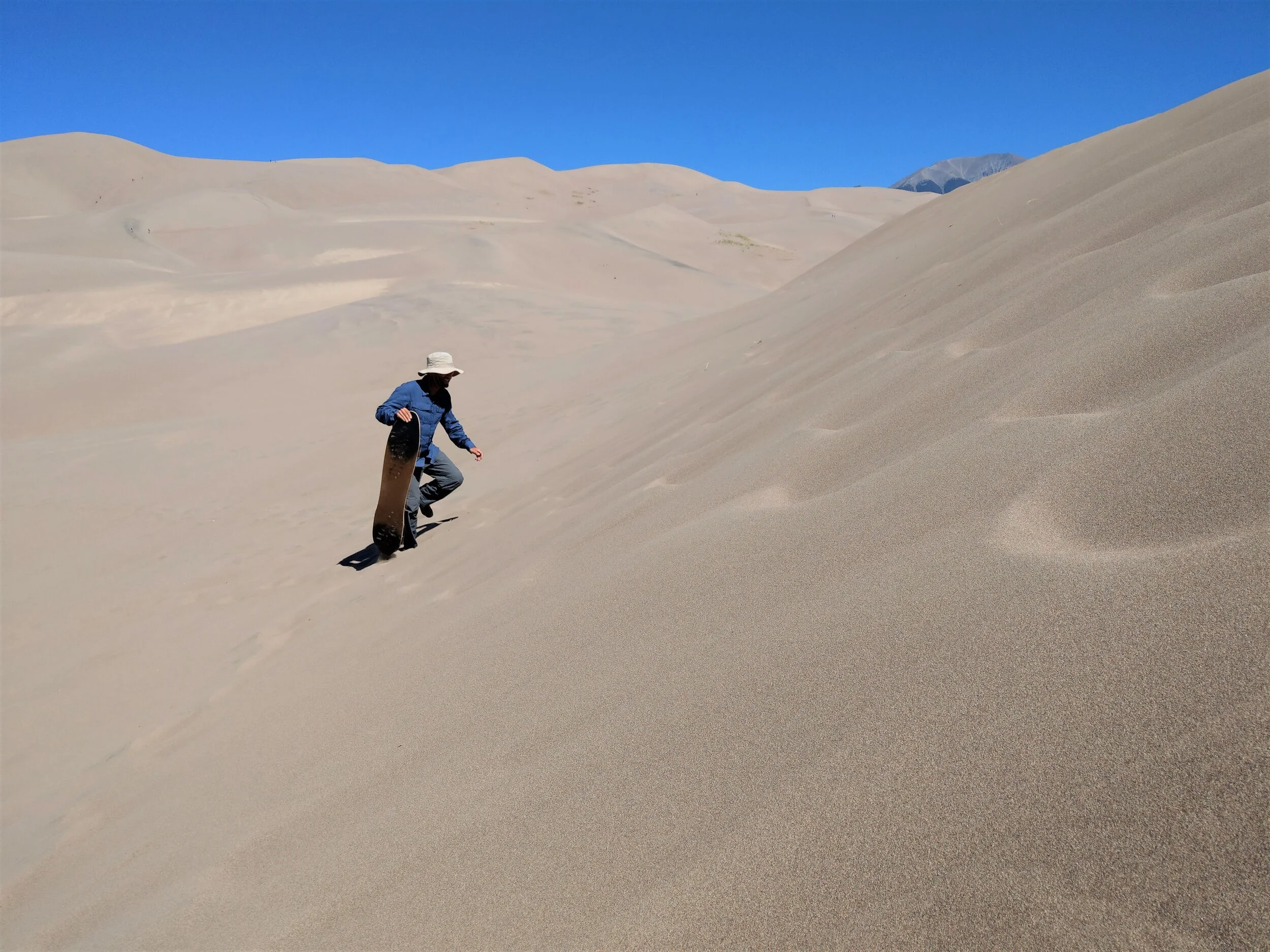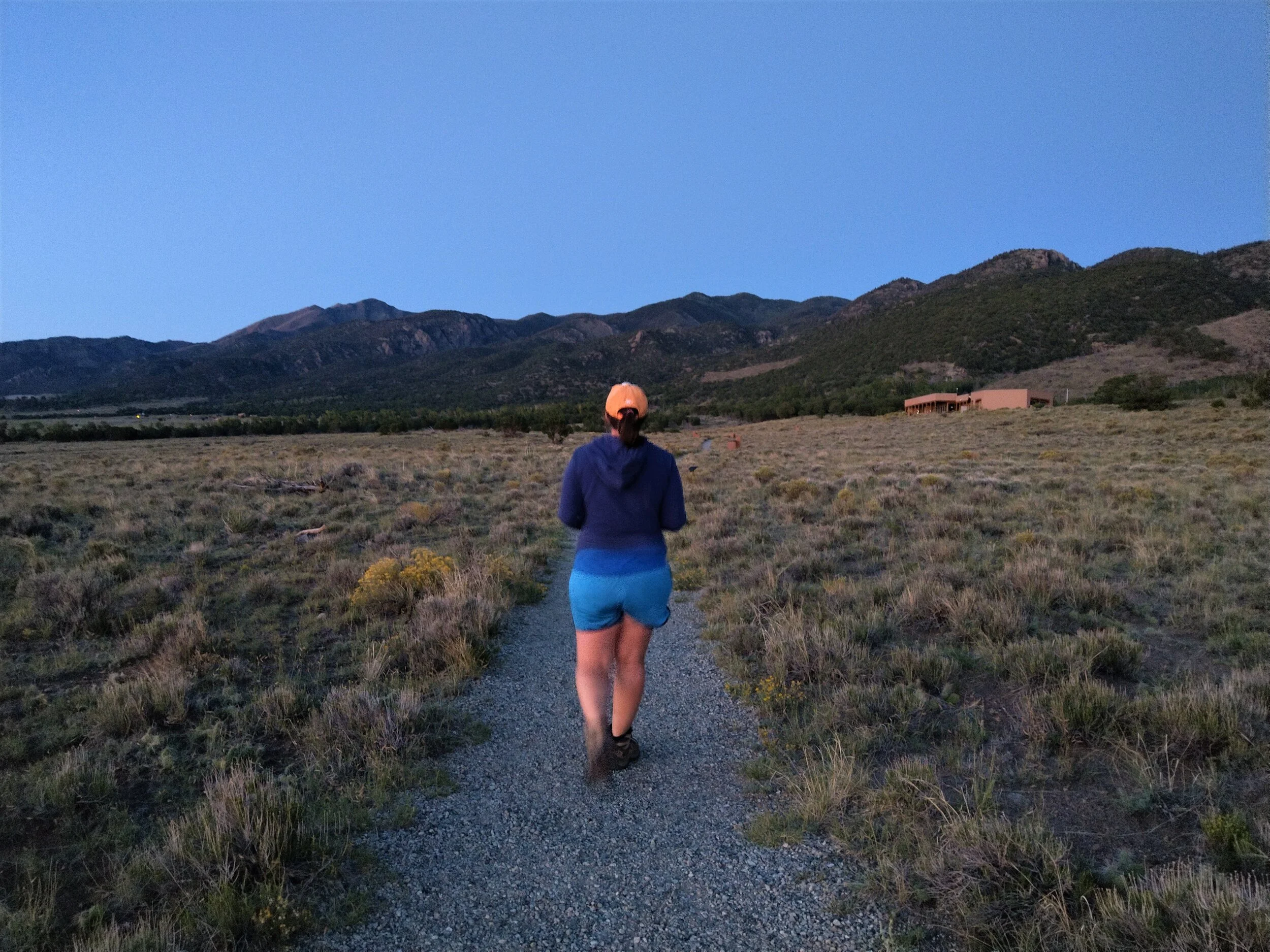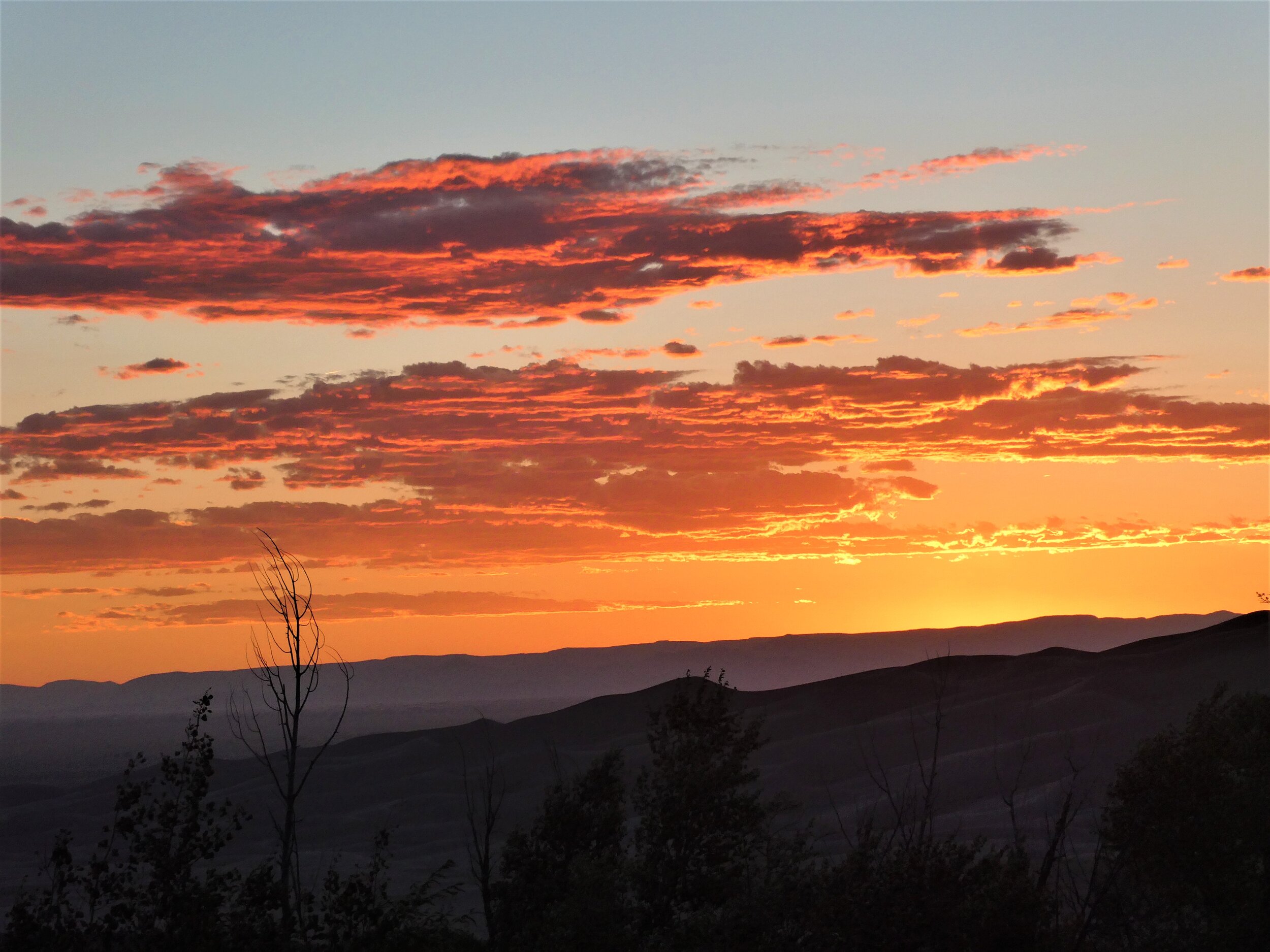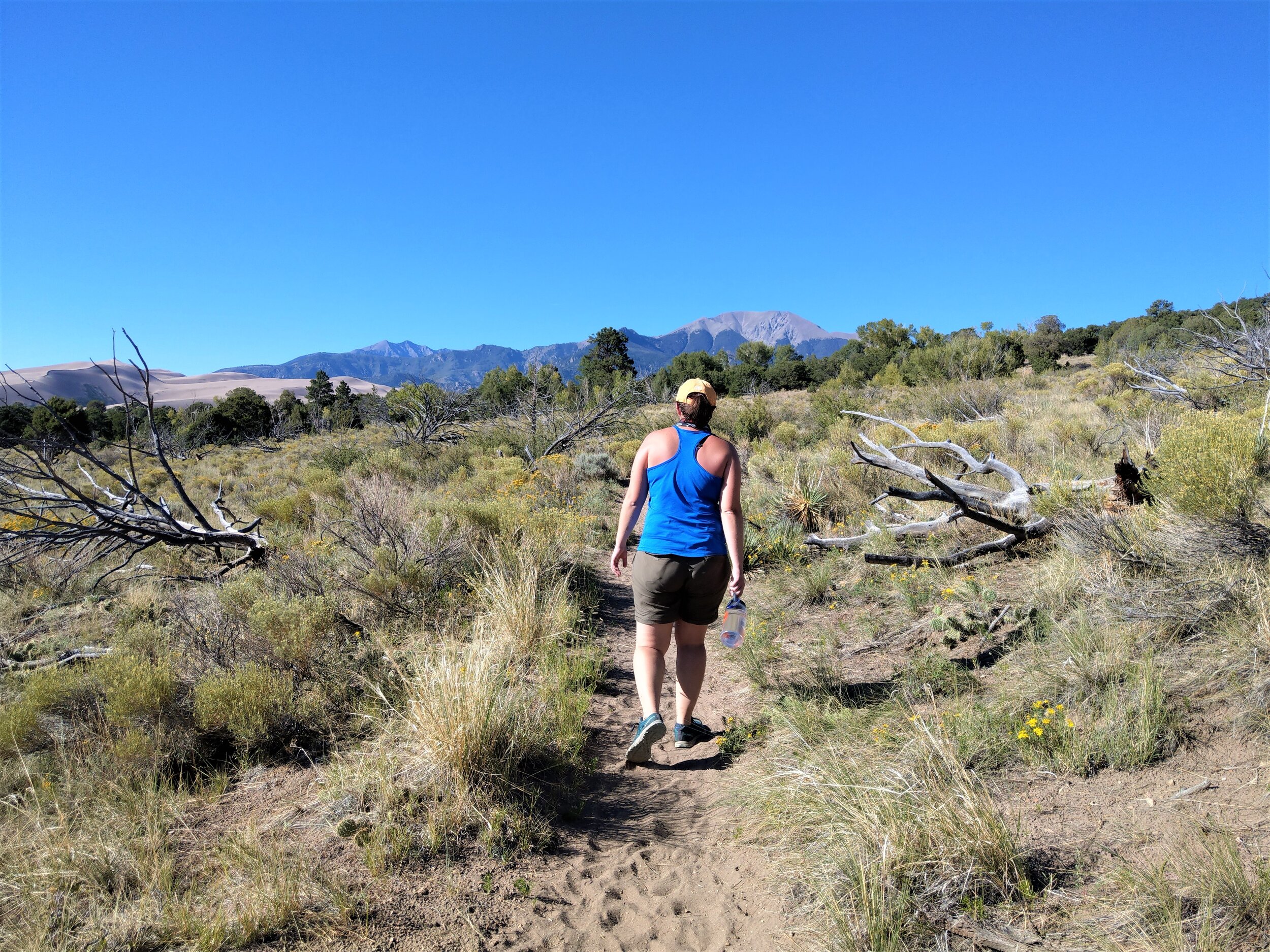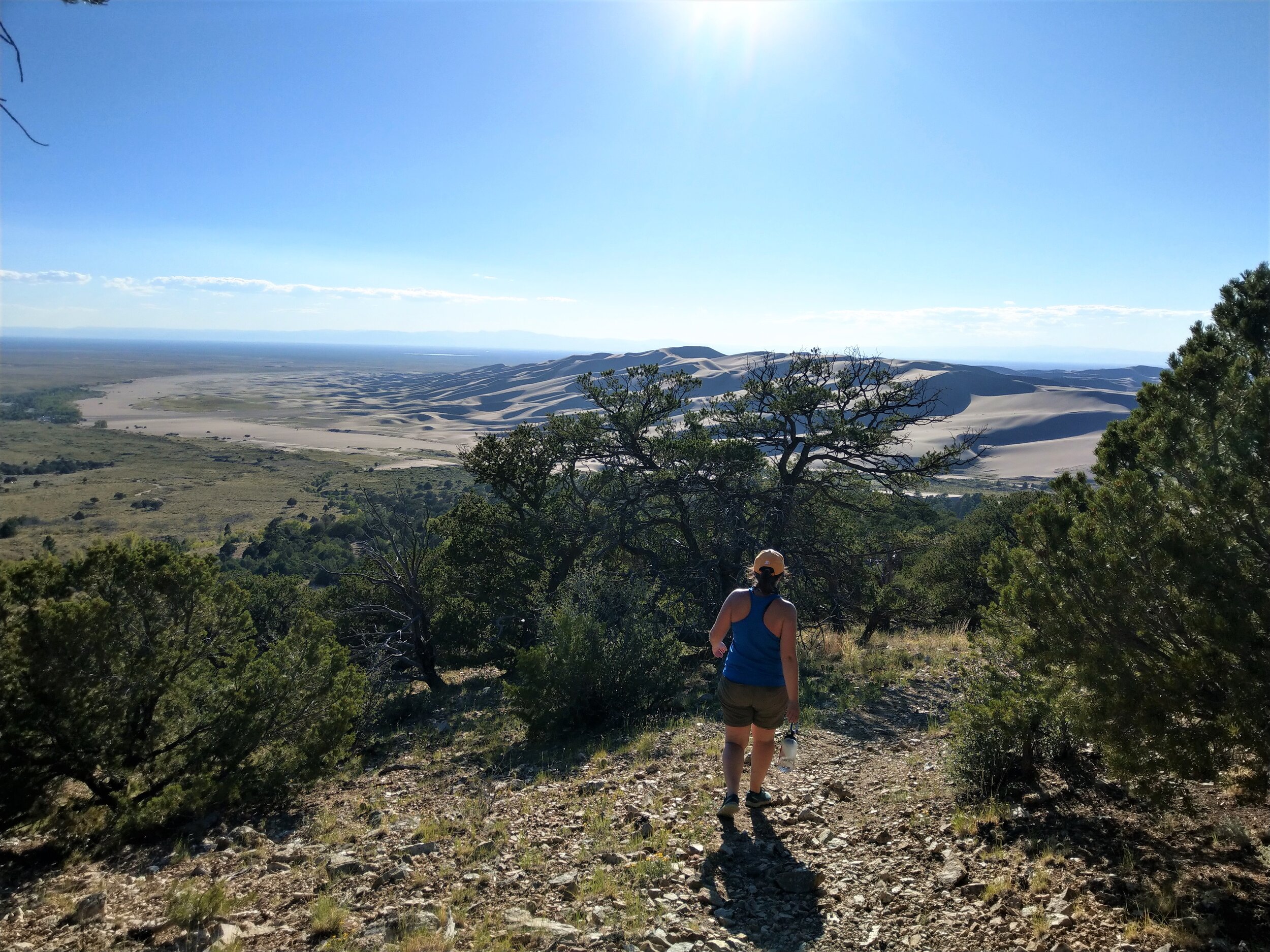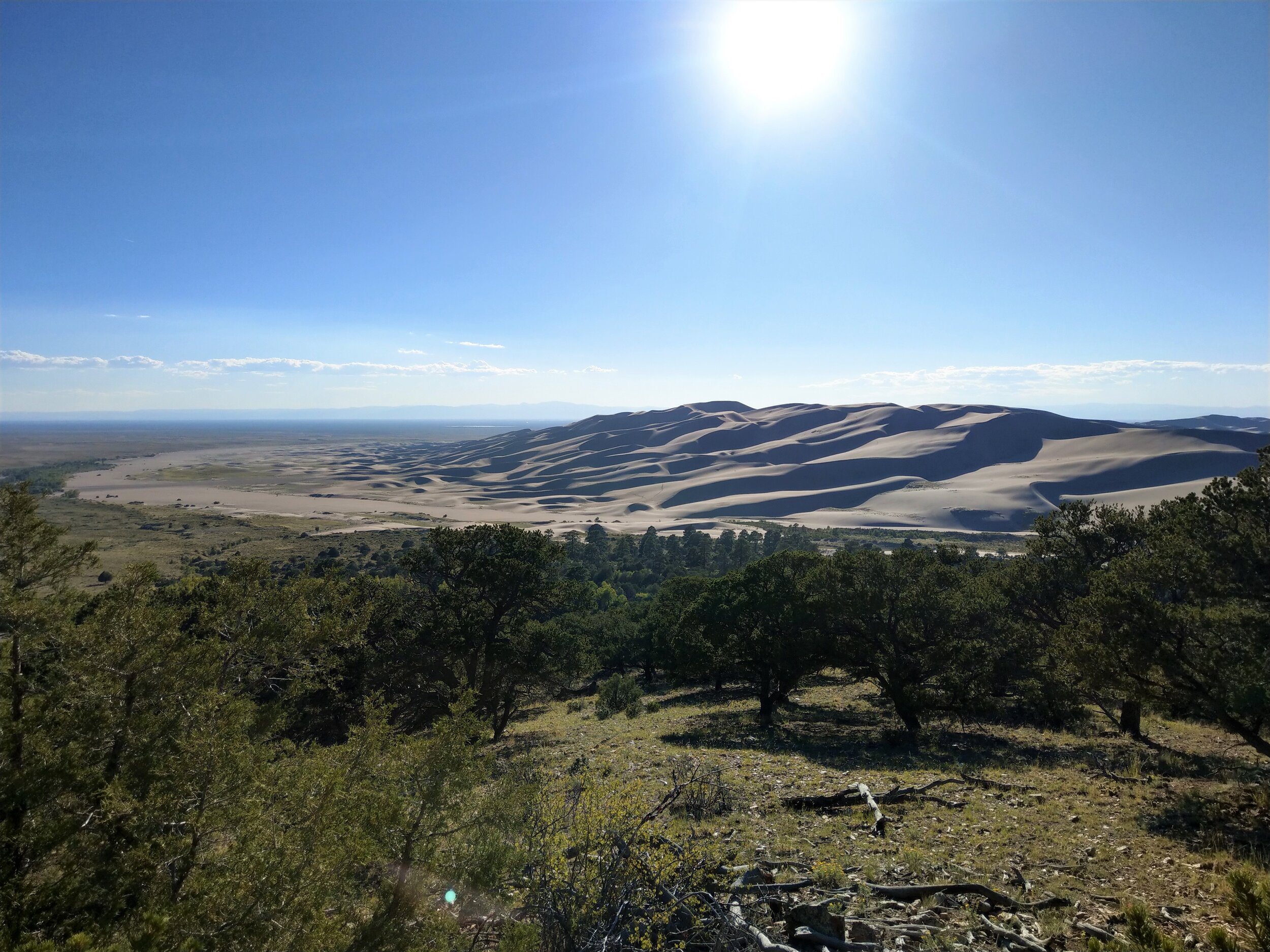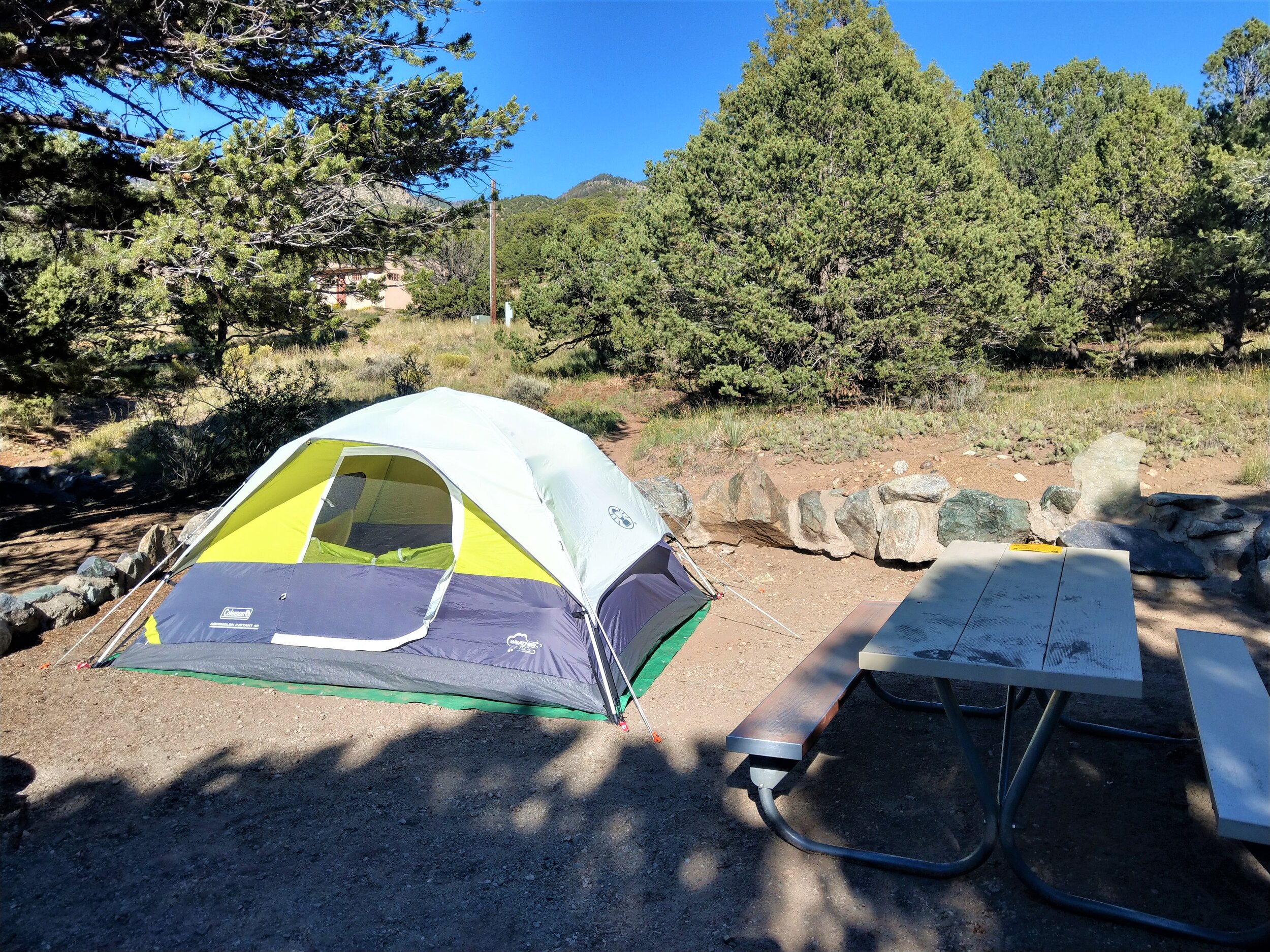Top 7 Things to Do at Great Sand Dunes National Park
What comes to mind when you think of Great Sand Dunes National Park? Well, big piles of sand of course! And that’s exactly what we were going there for…we were especially looking forward to visiting this park on our road trip through Colorado because we were excited to try for the first time one of the most common things to do here…sandboard!
Whether its by sandboard, sand sled, or your own two feet, there are 30 square miles of sand dunes to explore to your heart’s content, including the tallest sand dune in North America. But, did you know that there’s so more to Great Sand Dunes National Park than just the dunes?
We were quite surprised to learn that beyond the dunes, there’s a whole forest and alpine environment within the park boundaries you can explore! The catch? You will need a high clearance 4WD vehicle to get to many of the places outside of the dunes. But don’t worry, even if you don’t have one of those, there are still plenty of ways to stay busy during your visit.
In this post, we’ll go over some of the best things to do at Great Sand Dunes National Park, from hiking, to sandboarding, to stargazing, to finding solitude at high alpine lakes, including our best tips, when to go, how much time you’ll need to visit, and more!
Article Contents
How much time to spend at Great Sand Dunes National Park
Best things to do at Great Sand Dunes National Park
Hiking to High Dune
Sandboard at Great Sand Dunes
Medano Creek
Hiking at Great Sand Dunes
Explore the backcountry with a 4x4
Check out the night sky
Camping at Great Sand Dunes
Want to save for later? Pin this post and come back when you’re ready!
A guide to Rocky Mountain National Park
Best things to do on the North Rim of the Black Canyon of the Gunninson
Best things to do on the South Rim of the Black Canyon of the Gunnison
How Much Time Do You Need at Great Sand Dunes National Park?
The amount of time you need at Great Sand Dunes National Park really depends on the type of vehicle you have.
Overall, it’s a fairly small park and you don’t need too much time, but having a high clearance 4WD car really opens a lot more of the park up to you.
Basically, the main sites of the park lie along one short paved road that stretches from the park’s entrance to the Pinon Flats Campground. Along this stretch of road, you’ll find the visitor center, a couple of short interpretive trails, the parking lot for the sand dunes, and the campground. And this is about the extent you can explore in the park with just a 2WD vehicle.
Just past the Pinon Flats Campground is an area called the Point of No Return. Sounds kinda ominous. It’s not! It’s just the point where the road becomes the Medano Pass Primitive Road and is accessible only to those with a high clearance 4WD vehicle – and this is definitely a must. The road has soft sand, rocks, and small stream crossings. But this road gives access to beautiful backcountry scenery, some secluded campsites, and the Medano Lake Trailhead.
Another point of entry into the park requiring a 4WD vehicle is found to the east of the park, off of route 69, and will take you to the Music Pass Trailhead from which you can access several backcountry alpine lakes.
With all this in mind, how much time do you need to spend at Great Sand Dunes National Park?
If you only have a 2WD car, the park can be visited in just a single day. Spend the early morning and evening hours on the dunes, hiking, exploring, and/or sandboarding. During the midday when the sand gets quite hot, hike some of the short forested trails and spend some time at the visitor center.
If you do have a high clearance 4WD vehicle, you can keep yourself busy for at least 2-3 days at Great Sand Dunes. Spend a day in the main areas as described above. Then, take a day to drive Medano Pass Primitive Road, and perhaps another day to explore the Music Pass trails.
We’ll go over each of these awesome things to do at Great Sand Dunes National Park next…
Best Things to Do at Great Sand Dunes National Park
With 30 square miles of pure sand dunes, you can spend all your time hiking, exploring, and sandboarding the dunes. While that’s what most people do, there’s actually so much more to this unique national park! Here we’ll go over some of the best things to do at Great Sand Dunes.
1. Hike to High Dune
From the Sand Dune parking area, you’ll easily spot what looks like the tallest dune along that first ridge of sand dunes. This is High Dune and hiking to the top of High Dune is one of the most popular things to do at Great Sand Dunes National Park.
Standing at 699 feet, High Dune isn’t quite the tallest dune in the park (that title goes to Star Dune), but it’s much quicker to get to than Star Dune and it still gives great views over the entire dune field.
As you might guess, there’s no designated trail to the top of High Dune…it’s sort of just a free for all. Take a look at the dunes from afar and just plot out what seems like the path of least resistance.
The park service quotes an average of 2 hours and 2.5 miles roundtrip to reach High Dune, which was pretty much spot on for us. We mapped 2.4 miles, with an hour and 20 minutes to get up to the top, and about 35 minutes to get back to the parking lot (yea…it’s a lot faster going down!). Keep in mind, to get from the parking lot to the base of the actual dunes is about a half mile slog across the sand, and then you start your climb up!
Just an fyi, hiking in sand can be tough! It’s not a particularly big hike but the sand makes it pretty tiring. On particularly steep sections, it feels like for every one step up you take, you sink back down two. However, most of the hike was along moderate and well-trodden ridges that weren’t too difficult. We kept our target is sight based on the group of people standing at the summit.
The views from the top are gorgeous, with expansive views out across the entire dune field and the Sangre de Cristo Mountains.
Once you’re at the top, the hard part is over. Now it’s the fun part…heading back down! This is much faster than the hike up, and it’s easiest just to run down the sand as fast as you can, making sure to dig your heels in as you go and letting the sand guide you downhill.
Some tips for hiking to High Dune
In the summer, the sand temperature can reach as hot as 150°F! Yikes, that’s hot. It’s highly recommended you plan your time on the sand for morning hours or evening hours because of this and also just to avoid the intense midday heat (avoid the dunes between 12-4pm), especially in July and August.
Our experience: We visited the dunes in the first week of September and started our hike to High Dune at 5pm and had no issues. The next day, we were on the sand until 1 pm sandboarding. Around noon, I could tell the sand was getting pretty hot to the touch but it was still ok. By 1 pm, I could definitely feel it through my socks (it’s best to snowboard in socks and not shoes) but if I kept moving and didn’t stand still for too long it was fine. I’m sure in the hotter prime time summer months it might feel even hotter!
Wear closed toed shoes, and expect to have a shoe full of sand when you’re done. I turned it into a competition with Kevin to see who could empty out the most sand from their shoes in the parking lot (…I won).
Always check the forecast before you head out. As common in most places in Colorado, afternoon storms are normal. Keep an eye out for storm clouds in the distance. If you see them, start heading down.
Be sure to bring plenty of water, and wear sunscreen and a hat.
Don’t forget that these dunes sit at 8,000 feet! You might feel the effects of this altitude as you’re climbing up the dunes. Take it slow and drink lots of water.
Alternatives to hiking High Dune
Star Dune – Star Dune is the tallest dune not only in Great Sand Dunes National Park, but in North America, standing at 750 feet. However, hiking here is a bit more of a journey. You can’t see Star Dune from the dune parking lot, as it’s blocked by the first ridge. If you hike about 2 miles south along the base of the dunes (the Medano Creek bed), Star Dune will come into view. Then from there, you can just follow up the ridge lines to the top. The park service estimates this to be about 8 miles round trip, taking roughly 6 hours.
Just explore! – you don’t have to climb the tall dunes to have fun! The dunes make up 30 square miles, and if you don’t have your mind set up climbing to High Dune, it’s easy to find your own space away from the crowds, and even find that picture-perfect untouched sand.
Where do the sand dunes come from?
Just a quick side note in case you’re curious where this giant, seemingly random, pile of sand came from in the first place…I know I was! There’s tons of information about it at the park, but the short story here is that, believe it or not, most of the small grains of sand came all the way from the San Juan Mountains, over 65 miles away! Larger pebbles and grains mixed in from the much closer Sangre de Cristo Mountains. This sand mixture washed into what was once a giant lake covering the valley floor at the base of the Sangre de Cristo Mountains, and after this lake disappeared, a few different directional winds piled and shaped up the dunes into what they look like now.
2. Sandboarding and sand sledding at Great Sand Dunes
If you ask people what their absolute favorite thing to do at Great Sand Dunes National Park was, many of them would tell you the sandboarding. It certainly was the thing we were most excited about before our visit!
But if this is your first time, I’ll let you in on a little tip…sandboarding is hard. Ok, maybe not for the more athletically inclined or experienced snowboarders out there who might just naturally pick it up, but for the rest of us…don’t expect a whole lot of success here.
If this is your first time, expect a lot of falling. And while you might expect otherwise, falling in sand is not a soft landing. After a few good falls, we were feeling pretty beat up!
Some tips for sand boarding at Great Sand Dunes National Park
You don’t need to hike out far. Well, everyone needs to hike across the Medano Creek sand bed for about a half mile before reaching the base of the dunes. But from the base, you don’t need to hike all the way up to the tall dunes to find good sand boarding spots. Trust us, if you’re a beginner, you won’t want to. Just head up to the first small sand hills to see how comfortable you are on the board first, and then as you get more used to it, head up to bigger dunes if you feel like it. Or, just stay on the small dunes the whole time…they’re just as fun!
You won’t need all day. Plan for just a couple of hours on the boards. It is very tiring. Because remember, for every five second ride down a sand dune, you have to spend several minutes climbing all the way back up said sand dune. Unless you’re super human, you won’t need more than a few hours.
Aim for early morning or evening. Like we said above, it’s best to avoid the midday heat and burning sand. When boarding, it’s recommended you do it in your socks instead of shoes, so you’ll feel the heat of the sand a little bit more through your socks.
Use the wax they give you. Any rental place will give you board wax to scrape onto the bottom of the board. You’ll learn pretty fast that this is a necessity, or you won’t be going anywhere. But, also don’t go crazy on the wax, or you might go too fast…or at least faster than you want to be going. I used the wax very sparingly to get myself going just enough (going down hills at high speeds is not really my thing…). So you can use the wax roughly to adjust how fast you want to be going, which is nifty. It’s not a perfect science here, but it helps to know this.
Rent half the number of boards you think you need. Like we said, this is tiring, so if you want to save money, rent one board for every two people. Each person will appreciate the break as the other uses the board themselves.
Prepare to have sand everywhere when you’re done…in your shoes, in your clothes, in your hair, maybe in your mouth… there are some showers to rinse your hair and feet out at the dune parking lot, but keep in mind that if you’re camping at the park, the Pinon Flats campground has no showers. Expect to find bits of sand on you and your clothes for a good few days.
Bring a bandanna to wear over your mouth while boarding, which can help keep some of the sand out of your mouth, especially if it’s windy.
If you think sandboarding might be a bit much, there’s another option…
Sand sledding at Great Sand Dunes
Ok, sand sledding is something we can get behind!
We both rented sandboards for the day. I’m not sure what we were thinking. I’ve tried snowboarding for years and never got it down, and Kevin is a skier, not a boarder. But hey, we thought sandboarding just looked so cool. We didn’t even consider sleds. Ha.
Well, yea…sandboarding was hard. We took a few rough falls, and we just couldn’t get it down. After a while, it wasn’t fun anymore. I was watching all the sledders, a bit envious. So we turned our sand boards into sleds by just sitting down on them…and let me say, it was so much fun!
If you do want to sled instead of sandboard, for sure rent the actual sleds. They are wider, with handles, and easier to direct. Although we did feel the boards went a bit faster because of their shape.
Where can you rent sandboards and sleds in Great Sand Dunes National Park?
You absolutely need special boards/sleds for the sand, regular snowboards or sleds from home won’t do.
The park actually does not rent boards or sleds. But there are several rental shops in the area. The closest to the park, and the one we used, is the Oasis Store. It’s just 5 minutes outside the park along the entrance road. We got there at 10 am and had no problem getting a board…there’s wasn’t even a line. To our surprise, when we called in advance, they told us no reservation was needed because they rarely sell out. They are a pretty good price, just $20 for the day.
For more places to rent sandboards and sleds, check out the park service website.
3. Play in Medano Creek
This is something we did not get a chance to do in Great Sand Dunes, but would love to, and if you come at the right time, playing in Medano Creek looks like a fun way to spend an afternoon in the park.
Medano Creek is a seasonal creek that runs along the base of the dunes. It’s water level of course depends on that season’s snowmelt and rain, but it usually flows April through June. But what’s cool about this creek is that it displays a phenomenon called surge flow during its peak flow, usually in late May or early June. This happens when piles of sand form and fall into the creek bed, causing surges of water that resemble waves at a beach. During this time, you can find people on rafts and inflatable tubes, riding the waves down the creek. Check out the best times to go to experience the Medano Creek on the NPS site.
During other times of year, the creek is dried up. In the summer months, you can expect lots of mosquitos in this area, although when we were there in early September, we didn’t encounter a single one.
4. Take a hike in Great Sand Dunes
Like we mentioned above, there is a whole other dimension to the park outside of the famous sand dunes.
Along the park’s main road, you can access a handful of short loops and interpretive walks through the grasslands and forests surrounding the dunes. Hiking these trails is a great thing to do in Great Sand Dunes National Park during the middle of the day when the dunes themselves are quite hot. Plus, these don’t get crowded at all, as they get overshadowed from the park’s main attraction. We had pretty much every trail we hiked to ourselves.
Some of the trails to choose from include:
Sand Sheet Loop – This is a small (0.25 miles) interpretive loop that starts right from the visitor center. It will take you through the grasslands, with various stops along the way to learn about the landscape and vegetation.
In these neighboring grasslands, especially along the entry roads making their way to the park, it is common to spot elk and mule deer.
We took an evening stroll here to try and spot nighttime wildlife. You can see the visitor center in the distance.
Monteville Nature Trail – Another short (0.5 mile) interpretive loop, but through a forested trail. You can pick up a trail guide at the visitor center to learn more about the habitat as you hike. We hiked here at dusk to see if we could spot any of the park’s nighttime wildlife. We had no luck in that department, but we did see a killer sunset over the dunes.
Mosca Pass – This is a longer out and back trail to a low pass in the Sangre de Cristo Mountains that climbs 1400 feet in 7 miles roundtrip. We didn’t do this one but if you’ve done it, let us know how it is!
Dunes Overlook Trail – This is an out and back trail starting from the Pinon Flats Campground (if you’re not staying there, there’s a small parking lot in the campground right at the trailhead). The trail is about 2 miles roundtrip with a 400 foot climb. It’s a pretty easy uphill walk, but the last 0.8 miles gets pretty steep up some loose rock, but it’s over quick and takes you right to the overlook. From here, you get a cool bird’s eye view of the dune field. We think it’s worth the short trek.
5. Explore the backcountry of Great Sand Dunes
Like we said above, so much more of Great Sand Dunes National Park opens up to you if you have the right vehicle. With a high clearance 4WD car, you can access the much less visited, and quite unexpected, alpine environment of the park.
Without a 4x4, we couldn’t explore beyond the park’s main road, but here is what you can do if you have one (and what we will be doing when we inevitably go back!):
Medano Pass Primitive Road
Just beyond the Pinon Flats Campground, the road becomes unpaved and ends at the Point of No Return. This is the start of the Medano Pass Primitive Road, a rough unpaved road that requires high clearance and 4WD capabilities. The road has creek crossings, rocks, holes, and soft sand, and closes under certain conditions and in the winder. Check out the NPS site for the road’s status. The road is 22 miles long and is estimated to take around three hours to drive.
If you’re interested in driving this road, we recommend you check out some videos of the road to get a sense of what it’s like. It looks pretty rugged…like, you have to drive over boulders type of rugged…and lots of people have issues. It seems a pretty hardcore vehicle is needed.
Medano Pass Primitive Road is a scenic backcountry drive that connects out to route 69 outside the park. On this road, you’ll find:
Backcountry car camping – kind of an oxymoron, I know, but there are 21 designated primitive sites along the road. These are first come first serve and have no facilities.
Sand Ramp Trailhead – this is a backcountry route that gives access to the Sand Creek drainage and the Sand Creek Lakes (but as you’ll see below…there’s a much easier way to access these lakes).
Picnic areas – Ponderosa Point and Castle Creek picnic areas are located off this road with views of the dunes and mountains.
Medano Lake – Just before Medano Pass, at 10,000 feet, is a short spur road to the Medano Lake trailhead. This is a 7.4 mile roundtrip hike with a 2,000 foot gain to a high alpine lake. From the lake, you can climb up to the summit of Mount Herard (at 13,300 feet) with views over the sand dunes and Sangre de Cristo Mountain range.
Music Pass
Off of route 69 to the east of the park is another 4x4 road into the park that leads to the Music Pass Trailhead. From this trailhead, you can access Music Pass (just one mile from the trailhead) and the Lower and Upper Sand Creek Lakes (about 8 miles roundtrip and 2,000 foot gain to either). Because of the altitude and climate, Late June to August is best for this adventure.
If you don’t have a 4WD, you can still access this part of the park by simply parking your 2WD car before the road gets rough (at Grape Creek). This adds 5 miles round trip to any hiking, though.
If you really want to check out this backcountry but don’t have a 4WD, check out Pathfinders for Jeep Rentals.
6. Experience the night life of Great Sand Dunes
Ok, not that kind of nightlife...
Experiencing the park at night is an awesome thing to do if you’re staying in or near Great Sand Dunes. Because it’s far from artificial lighting, the stars really come out, especially on a moonless night. Check the moon calendar before you visit, or the park posts this kind of information at the visitor center and campground.
From the expansive dune field, you can get great views of the start, or you can hop on a ranger night program at the park’s amphitheater.
If it’s a full moon and a bright night, the stars might not be out, but it would still be a cool experience to walk along the dunes at night under the light of the moon.
At dusk and nighttime, you can also walk along the short interpretive trails in search of wildlife like owls, salamanders, and kangaroo rats.
7. Camp at Great Sand Dunes National Park
There is no formal lodging inside the park, so camping is the only way to spend the night inside of Great Sand Dunes. There are two ways to do it…frontcountry or backcountry camping.
Frontcountry camping in Great Sand Dunes National Park
There is one frontcountry campground in the park – the Pinon Flats campground located at the end of the paved portion of the park’s main road. It’s a decent campground with flush toilets (no showers…keep that in mind after a day of playing in the sand!).
The campground is open from April until the end of October and sites are reservable 6 months in advance up to four days in advance at recreation.gov for $20 per night. All unreserved sites are made first come first serve.
If you can’t get a site inside the park, there are campgrounds and BLM land nearby.
Backcountry camping in Great Sand Dunes National Park
How cool would it be to camp among the sand dunes themselves? Pretty cool, but also pretty sandy we would imagine.
But, you can do just that! Apply for one of the 20 daily permits to backcountry camp in the dunes on recreation.gov up to three months in advance. You can camp anywhere beyond the first high ridge line, so you’ll hike a minimum of about a mile and a half across the sand before setting up camp.
The permits used to be free, but just recently (for 2021) have become $6 per permit due to the apparently growing popularity of this activity and the need to fund more dedicated resources. Still a small price to pay in our opinion for a night of solitude under the stars.
Camping on Medano Pass Primitive Road
As we mentioned above, there are 21 sites along the Medano Pass Primitive Road. These are kind of like a hybrid site…they are technically backcountry, but it’s also car camping, since the sites are right along the road. These don’t require permits and are simply first come first served.
And that’s a wrap! What was your favorite thing to do at Great Sand Dunes, or if it’s still on your list, what are you looking forward to the most? Let us know in the comments below!


